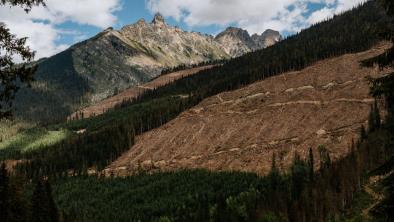B.C. logging practices “chipping” away at caribou survival

Environmental groups call on B.C. to close loopholes and stop approving habitat destruction
VANCOUVER / UNCEDED xʷməθkʷəy̓əm, Sḵwx̱wú7mesh AND səlilwətaɬ TERRITORIES —
Wilderness Committee and Wildsight have discovered legislative loopholes that enable extensive logging in critical southern mountain caribou habitat in B.C.
In 2009, the B.C. government put protections in place for deep-snow caribou — ranging from areas primarily off limits to the forest industry (no harvest zones) to areas where certain less effective prerequisites to log are in place (conditional harvest zones).
According to our new map analyses, more than 78 hectares of no harvest zones (NHZ) — set aside for caribou in the Revelstoke area — have been logged or approved to be logged since then. An additional 1,367 hectares were logged in conditional harvest areas since the protections were put in place.
Between 2018 and 2024 alone, B.C. approved eight cutblocks that overlap — by 37 hectares — with the no harvest ungulate winter range protections. One of these incursions was as large as 9.1 hectares. These cutblocks are within the critical habitat of the recently extirpated Columbia South herd and the endangered Columbia North herd of deep-snow caribou.
“We cannot continue to chip away at protections and critical habitat, and expect different results. We’ve lost seven caribou herds in the last two decades in the Kootenay and Columbia region,” said Eddie Petryshen, Conservation Specialist with Wildsight. “These conditional harvest areas in particular are not effectively protecting caribou habitat as over 1300 hectares have been logged in the habitat of a herd that otherwise could have strong long term viability.”
B.C.’s deep-snow dwelling caribou have declined — from approximately 2,500 in the late 1990s to 1,250 today. Over the past two decades, only 10 of the 18 subpopulations (herds) remain on the landscape in southern and central B.C. Habitat loss, degradation and fragmentation from logging, particularly old or primary forest, are the largest contributors to deep-snow caribou decline.
The Columbia North herd, which roams the Upper Columbia and Northern Shuswap, has increased to 210 caribou in recent years. Protecting their habitat is the only way to ensure they don’t meet the fate of their now extirpated South herd neighbors. Sadly, only 35 percent of Columbia North’s core habitat is protected. And our analysis shows portions of these protections being chipped away at.
“You can’t call them no-harvest zones if logging is still on the table. Destruction and protection cannot co-exist ,” said Lucero Gonzalez, Conservation and Policy Campaigner with Wilderness Committee. “For a species as endangered as southern mountain caribou, partially protected critical habitat is a slow path to extinction”
Deep snow caribou require large areas of old and primary forests to find food and avoid predators. In winter, when other food is buried in deep-snow, they stand on their huge snowshoe-like hind feet to feed on lichens growing on old-growth tree branches — that’s why they are called ‘deep-snow caribou. New research from the University of British Columbia confirms this dependency on hair lichen, warning that abundant hair lichen can only grow in advanced aged old-growth forests, and that restorating such lichen is virtually impossible in young forests.
“A cutblock created today within the core range of deep-snow caribou won’t support caribou and their winter food again for 120 to 150 years at a minimum. That’s how long it takes for forests to produce enough hair lichens — their primary winter forage — to sustain them,” said Trevor Goward, researcher and international authority on caribou-forage lichens. “It’s impossible to log caribou habitat without permanently destroying its value for caribou.”
Wilderness Committee and Wildsight fear these incursions in provincially designated caribou ungulate winter range could become more frequent as logging companies become more constrained and run out of areas to log. In the holiday season when reindeer are one of the most celebrated species, they are calling on B.C. to stop approving roads and cutblocks in no harvest zones and to fully protect all provincially-identified core caribou habitat.
For more information, please contact:
Lucero Gonzalez Ruiz | Conservation and Policy Campaigner, Wilderness Committee
604-700-3280, lucero@wildernesscommittee.org
Eddie Petryshen | Conservation Specialist, Wildsight
250-427-9885, eddie@wildsight.ca
Trevor Goward | UBC Curator of Lichens
250-674-2553, trevor.goward@botany.ubc.ca
Background Information:
Photos: Please credit Bailey Repp, David Moskowitz and Siobhan Williams
Photos Caribou UWR Logging PR
Wilderness Committee Maps:
Approved and Pending Cutblocks, N Shuswap Lake, Conditional UWR as of Dec 2024.
Approved Cutblocks Revelstoke Lake No Harvest UWR as of Dec 2024
Additional Information:


